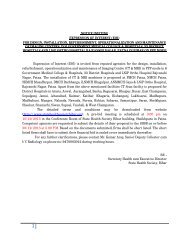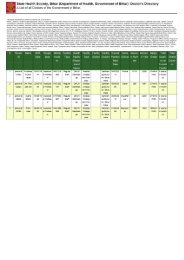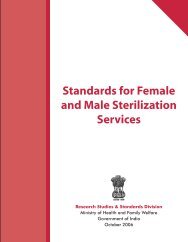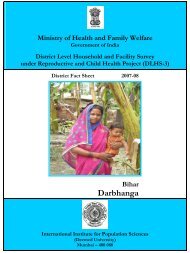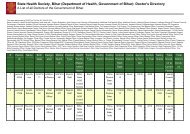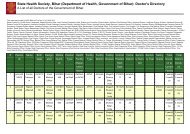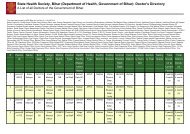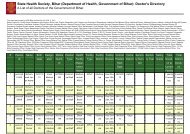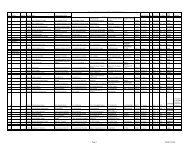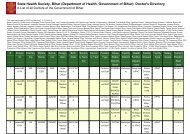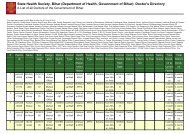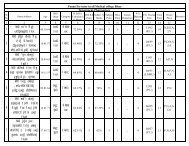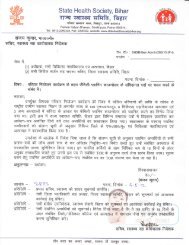District Health Action Plan - STATE HEALTH SOCIETY-----BIHAR
District Health Action Plan - STATE HEALTH SOCIETY-----BIHAR
District Health Action Plan - STATE HEALTH SOCIETY-----BIHAR
You also want an ePaper? Increase the reach of your titles
YUMPU automatically turns print PDFs into web optimized ePapers that Google loves.
Kala-azar scenario at Saran<br />
Goal<br />
To contribute to improving the health status of vulnerable groups and at-risk population<br />
living in kala-azar-endemic areas by the elimination of kala-azar so that it is no longer a<br />
public health problem.<br />
Targets<br />
� To reduce the annual incidence of kala-azar to less than one per 10,000 population at<br />
district by 2012.<br />
� Reduce case fatality rates<br />
� Prevent the emergence of Kala azar/HIV/AIDS, and TB co-infections<br />
B.3.3 Filaria control Programme<br />
The National Filaria Control Programme was launched in 1555 for the control of filariasis.<br />
Activities taken under the programme include: (i) delimitation of the problem in hitherto<br />
unsurveyed areas, and (ii) control in urban areas through recurrent anti-larval measures and<br />
anti parasite measures. Man, with micro Filaria in the blood is the main reservoir of infection.<br />
The disease is not directly transmitted from person to person, but by the bite of many species<br />
of mosquitoes which harbor infective larvae. Important vectors are species of Culex,<br />
Anopheles, Mansonia and Aedes. The incubation period varies, and micro-Filaria appears in<br />
the blood after 2-3 months in B. malayi after 6-12 months in W. bancrofti infections.<br />
Constraints<br />
� It affects mainly the economically weaker sections of communities<br />
� Result in low priority being accorded by governments for the control of lymphatic<br />
filariasis.<br />
� Low effectiveness of the tools used by the control programme<br />
� The chronic nature of the disease and that<br />
Suggestions<br />
� Single dose DEC mass therapy once a year in identified blocks and selected DEC<br />
treatment in filariasis endemic areas.<br />
� Continuous use of vector control measures.<br />
� Detection and treatment of micro-Filaria carriers, treatment of acute and chronic<br />
filariasis.<br />
� IEC for ensuring community awareness and participation in vector control as well as<br />
personal protection measures.<br />
103 | P a g e D i s t r i c t H e a l t h A c t i o n P l a n 2 0 1 2 - 1 3 D H S , S a r a n



